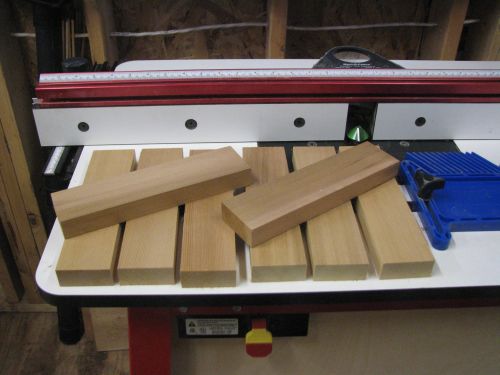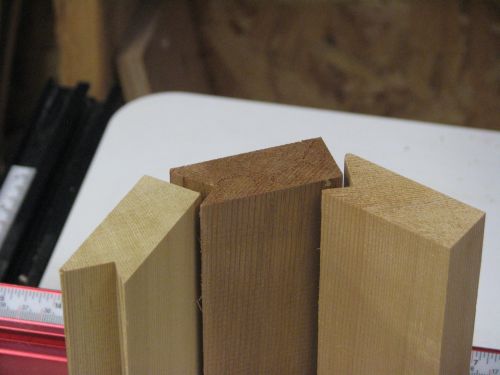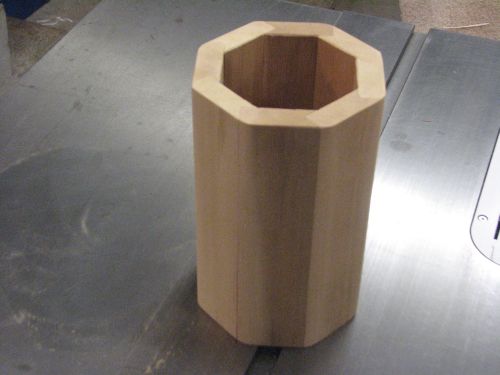I made two more of these, this time actually paying attention to the length of the shelf, which I made too short in the earlier version. Although the short one looks great where it is, these would actually be too long. Context is everything, right?
Oak bookshelf
Fun little oak bookshelf I made from some pretty nice quarter-sawn white oak… has some nice figure… simple double-boiled linseed oil finish…
Five Wine Stoppers
Another smart shopper allowed me to make these bottle stoppers in plenty of time for her holiday gift list. The three on the left are made from Pau Ferro, and the two on the right are Padauk. These are two of my favourite woods to work with. I also enjoy James Woods, but not so much Tiger Woods, though I’ve never actually worked with either of them.
Ten Wine Stoppers
Nov. 18, 2010: From a variety of woods (curly maple, padauk, pau ferro), these ten bottle stoppers are all for a very clever client who got her holiday shopping done early! But I can always make more, just holler…
Pen and Letter Open Sets
Finally finished the Pen and Letter Opener gift sets. I even sprang for the — let’s call it “leather” — gift case, because they’re just that classy. Like me. Classier, even… These are available for purchase via my Etsy store (links below). Owen Sound locals, just chat me up, obviously no need to pay shipping!
There’s the one set in Lacewood I posted yesterday, plus now two in Bubinga, and two in Stinkwood. Which I promise does not stink and is in fact rather awesome… Five sets only. Great for gifts! Act now!

African Stinkwood Pen and Letter Opener, with case.
Buy on Etsy:
www.etsy.com/listing/61456262/pen-and-letter-opener-set

African Bubinga Pen and Letter Opener, with case.
Buy on Etsy:
www.etsy.com/listing/61455857/pen-and-letter-opener-set

Australian Lacewood (Silky Oak) Pen and Letter Opener, with case.
Buy on Etsy:
www.etsy.com/listing/61359728/pen-and-letter-opener-set
“Cigar” Style Pen + Letter Opener – with case
The wood here was labeled as “Silky Oak” but looks exactly like what I’ve been getting as “Lacewood”… Wikipedia suggests they’re the same wood, from Australia.
Available for purchase from my Etsy store… don’t let the Holidays sneak up on you!!
http://www.etsy.com/listing/61359728/pen-and-letter-opener-set
Breadbox
Poplar Mailbox
This is a stained-poplar mailbox for my sister. Based more or less on the design of the one they’re replacing. The finish is several coats of Spaarrr Vaarrrrnish, like the pirates use. The hinges are “antique steel” from Lee Valley Tools (Link).
Mason Jar Cedar Vase
Continuing the octagon theme we have going on here at Barkwhistle, and continuing also to look for ways to use up some cedar scraps, I recently mitred together some small boards to make this small planter. Then I decided to try something a little bit different… instead of straight boring old miters, I though I would use one of these birds mouth router bits from Lee Valley Tools.
I showed the results of my first attempt to my wife, and she immediately declared that it would be a vase. It won’t hold water, says I. Well, maybe it will hold a mason jar, says she. And lo and behold, a perfect fit.
So here, just to amuse my own self, and/or in case somebody finds it useful, is a bit of an illustrated step-by-step description of how I built our second Mason Jar Cedar Vase.
1. Mill the pieces. I milled 8 pieces of Western Red Cedar, 2 1/4″ x 9″ x about an inch thick. It’s usually easier to work with longer pieces and cut them to final length, especially if you need to run them through the thickness planer, which would not be possible with pieces this length.

2. Rout the Bird’s Mouth. Using the “Birdsmouth 8” router bit (Lee Valley item number 16J40.58), and set up in a router table as shown, using a featherboard to ensure an even cut, I routed the bird’s mouth on one edge of each piece.

You can start to see how they will nest together. Pretty cool…

3. Dry-fit and tape together. Stand all the pieces on end and assemble the cylinder. Use your blue tape to tape the assembly together as snugly as possible. If the routing went well and the pieces were square to start with, it should magically come together beautifully.

You’ll notice in the photo above that the assembly is sitting on another piece of cedar. This piece will form the bottom of the vase.
At this point I went ahead and glued up the cylinder, trying to use just the right amount of glue to prevent squeeze-out. Again I used the blue tape to pull everything together. Didn’t use clamps, although I suppose I could have got out the band clamp. The masking tape can be pulled taut enough to get a good glue bond, I think.
4. Trace the bottom of the vase. You’ll need a wide enough piece of cedar to completely span the opening of the cylinder. Hold the cylinder firmly down on this piece, and reach down inside the assembly to draw a pencil line marking the inside octagon shape.

5. Cut out the bottom. I used the bandsaw to cut along the pencil lines to create the octagon-shaped bottom of the vase. I left the line showing, then used the disc sander to sneak up on the final fit. Being cedar, you could just as easily use a sanding block for the fine tuning.

6. Install the bottom. If you get really lucky, you might find that you have such a perfect fit that glue alone will hold the bottom in place. I wasn’t so lucky, and in any event, I decided that it needed something mechanical to hold it securely enough to be safe. So I countersunk and counter-bored four holes, and installed four 1 1/4″ brass screws to hold the bottom firmly in place.

7. Final Sanding. When the glue has dried, I went ahead with the final sanding and shaping of the cylinder. You have a couple of choices here. Depending on the original thickness of the pieces, and the position of the router bit, there will be groove between each slat of the cylinder. You can either plane and sand this groove away completely, forming a round cylinder, or just “touch it up” a little, and leave the groove as a feature. I left it groovy on the first one, but decided to sand it to form more rounded transitions on the second one, eliminating the groove, but still maintaining the octagon shape.

Note: Before finishing, I opted to pop a 1 1/4″ brad nail into each joint, around the top of the vase, just as a backup. This does leave a small dimple in the wood, so you may want to just rely on the glue joint if that’s a problem for you.
8. Apply finishing. I chose to apply a couple of coats of spar varnish, since I liked how it looked on the chairs I made. The first coat was diluted 50-50 with turpentine to enable good penetration, the second coat was applied full strength. Here’s a photo of the first model, the prototype, with its finish almost dry.

And that’s all there is to it. Just drop in a one-quart mason jar, a little water, and the vegetation of your choice!
(photo coming later, when the varnish dries…)
My Dust Collection (A Cautionary Tale)
Call me naive (go ahead, I’ll wait) but I always thought “dust collection” meant having a lovely collection of dust. For woodworkers, this is fairly easy to accomplish. And this particular dust collection is archeologically, or maybe geologically, quite interesting. It’s like examining the strata of an exposed canyon wall, to learn what has happened in the past, and in what sequence. In this case, the interior of my Delta X5 Jointer reveals the history of my surfacing several species of wood, notably cedar, maple, walnut, cherry, and purpleheart.
Seriously, it seems that even with a big-ass dust collector in use, you still have to periodically clear out the insides of your woodworking machines… who knew?








